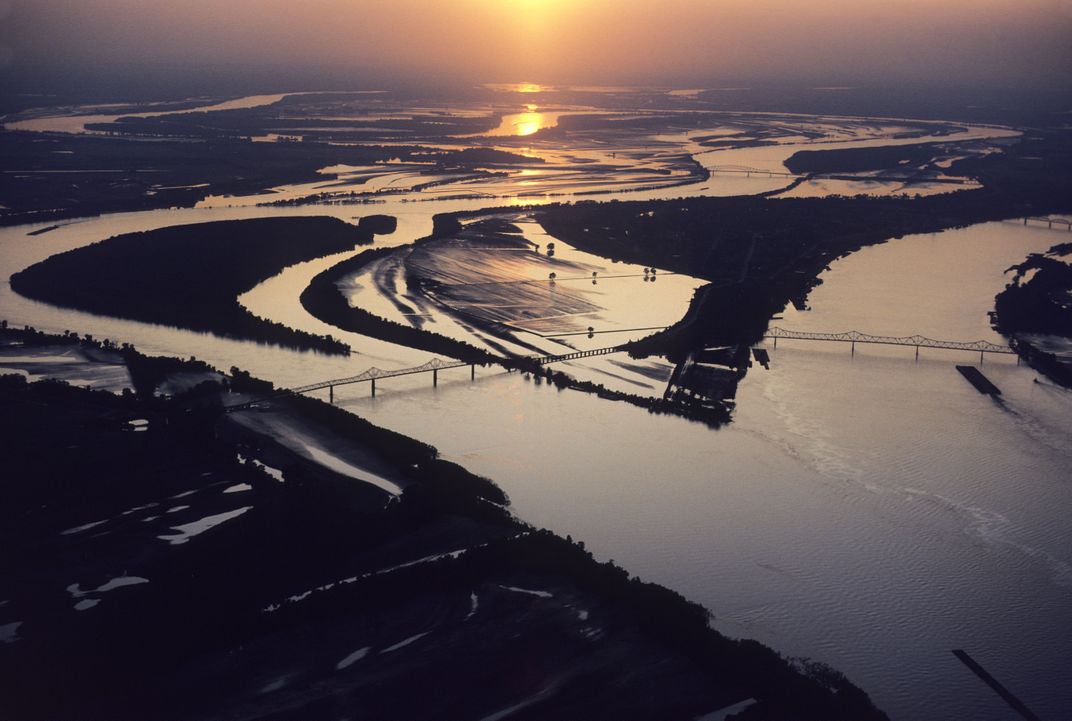My Life as a Mississippi River Rat
A half century spent on, in, and around our most all-American body of water
/https://tf-cmsv2-smithsonianmag-media.s3.amazonaws.com/filer/27/9c/279c7db9-26c3-4f08-8b71-0b2bb06dfd0e/42-57054627.jpg)
The first time I saw the Mississippi River was almost certainly from a bridge, when I was a child, looking through the backseat window of a Volkswagen bus. It was the 1960s, and we were on one of our semi-regular trips across America from New England to visit cousins, monuments, and roadside rest areas. The bridge would have begun in Wisconsin, where my father was born, or ended in Missouri, where my mother's people are from. My father, most likely, was behind the wheel, and my mother, most likely, was the one to sing out from the front seat, "Look, everyone look, it's the Mississippi River."
The river was filthy then, in those years before a bipartisan Congress functioned well enough to override Richard Nixon's veto of the Clean Water Act. It's hard today to fathom how bad the bad old days were, when letting freedom ring meant letting everyone, from the city of Chicago to the machine shop on Stinking Creek, send their untreated sewage and industrial waste downstream toward New Orleans and the Gulf. Nonetheless, from high above on the bridge, the Mississippi was also a creature of beauty, slithering way to the north and south as my family headed west. Knowing what I know about myself now, nearly 50 years later, I have no doubt that I wished in my young heart to be traveling on that river and around those mysterious bends in an open boat rather than rolling along on the straight Midwestern macadam.
Some part of me has always been a river rat. The first thing I bought with my own money from summer jobs was a canoe, only to discover that with no license or car I could not move it to the Connecticut River, near where I grew up. The first book idea I ever pitched to an editor was to take that canoe down the Missouri, only to learn that if I were to make such a trip, I would have to pay for it myself. It took me five books, but I finally sold the river story and began to research the role of the Mississippi in North American history for my latest book Old Man River. Now I can travel much of the Mississippi River Watershed and call it my occupation.
What a deep history it is: mammoths and mammoth hunters; princesses and pirates; slave traders and songsters; Dickens, Melville, Audubon, Trollope, and of course Twain; Washington, Jefferson, Lincoln, Grant, and Hoover; catfish, paddlefish, and gar the size of your kayak. There could almost be no richer subject for a history, natural or human. And yet I found myself weighed down by all the historical documents until, almost in desperation, I cast off from my computer full of PDFs of primary sources and strapped on my PFD and slipped my boat once again into the great river and its tributaries.
There are many places along the banks I have visited repeatedly. Most are urban, though that is largely a function of the fact that business now takes me to cities so often. I've watched the river by the aquarium in New Orleans, where it is not particularly wide but boils by deep between its levees at a level visibly and disconcertingly higher than the city behind you. I've stopped in at the municipal boat ramp in Memphis, where the friendly folk in the office will point up 40 feet above their heads and say, "That's where the water was during the big flood a few years back." Under the arch at St. Louis, the Mississippi always seems to me like a dog that doesn’t yet know it’s been let (partially) off its leash; there it's set free at last from all the navigation dams upstream on both the Missouri and the Upper Mississippi.
At ball games in the Quad City River Bandits' stadium in Davenport, Iowa, on the other hand—the most beautiful ballpark I've ever been to—the Mississippi plays its all-American role. There it is a placid, hard-working thing of beauty that is not cowed by the indignities of pollution and navigational dams. It knows more than you do, and is patient.

Not all the places I revisit are in town. Both in a car and in a boat, I have stopped at Fort Defiance State Park in Cairo, Illinois, to watch the coffee-colored prairie water of the Mississippi merge reluctantly with the black-green forest water of the Ohio. This place above all others, to me, is where the river becomes The River. The relatively short Ohio River, draining the western slopes of the Appalachians, brings more water to the Mississippi than the Upper Mississippi and Missouri combined. Where the Ohio and Mississippi meet, at a strangely deserted and rundown park, the river on the west looks less like the Father of Waters than the nephew. Below Cairo, though, there is no question. You are on the big river.

It's all one river, I came to believe after four years of wandering. And there are places in the watershed that I haven't yet been to that call me. I only know them by name or reputation—the stretch of the Yazoo that hides 29 sunken Civil War ships, the passage between the Fox River and the Wisconsin across which the first Europeans reached the upper river. I want to see where the Dry Cimmaron in New Mexico becomes wet. There are too many places to list. They tug the way the current does when you are up to your thighs in the flow and know that it would far wiser to not have ventured any deeper than your calves.
The wallpaper on my phone these days is an image of an island on the Mississippi River below St. Louis and above Cairo. The shot looks over the shoulder of my teenaged son, past a campfire, and on to the Mississippi River, down which a barge the size of a football field is traveling. Of all the places I've ever been on any river or any road, that's indisputably where I would go again.
But I will not get to that moment again even if I return there with my son. An old proverb says you can never step into the same river twice, and it's true. No matter how many times I've gone down to visit the river—any river—it has never been the same. A river is not so much a place as it is a living phenomenon moving across and through a place and a time that are being created and destroyed by its presence. A river is not unlike a life: You don't go to a river simply to be there, you go to share a few moments with it, and hope that you remember it forever.
Paul Schneider is the author of five books. His most recent is Old Man River: The Mississippi in North American History, which The New Yorker described as “vivid history.” He wrote this piece for Zocalo Public Square.
Planning Your Next Trip?
Explore great travel deals
Smithsonian magazine participates in affiliate link advertising programs. If you purchase an item through these links, we receive a commission.